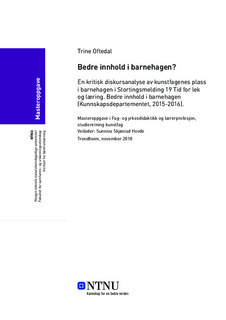| dc.contributor.advisor | Hovde, Sunniva Skjøstad | |
| dc.contributor.author | Oftedal, Trine | |
| dc.date.accessioned | 2019-05-25T14:00:46Z | |
| dc.date.available | 2019-05-25T14:00:46Z | |
| dc.date.issued | 2018 | |
| dc.identifier.uri | http://hdl.handle.net/11250/2598826 | |
| dc.description.abstract | Masteroppgaven er en kritisk diskursanalyse av Stortingsmelding 19 Tid for lek og læring. Bedre innhold i barnehagen (Kunnskapsdepartementet, 2016). Jeg bruker en abduktiv forskningstilnærming der jeg veksler mellom teori, metode og empiri. Min begynnende analyse gir et bilde av den politiske diskursen og dens relasjon med kunstfag- og barnehagediskursen, samt hvilken plass stortingsmeldingen har i diskursene.
Policy er et engelsk fagbegrep som sier noe om hvordan politikk hjelper mennesker å sette verden i system i tillegg til å ha makt til å både skape, opprettholde og videreutvikle diskurser. Policy-teori er dermed brukt for å få større innblikk i prosessen med å lage en stortingsmelding i tillegg til å gi nye perspektiver inn i en kritisk diskursanalyse.
Problemstillingen hvordan fremstilles kunstfagenes plass i barnehagen gjennom Stortingsmelding 19 (Kunnskapsdepartementet, 2016), og hvordan møtes diskursene fra barnehage, kunstfag og politikk er utgangpunktet for masteroppgaven. Jeg analyserer kunstfagenes plass i barnehagen gjennom begrep som beskriver kunstfagene i stortingsmeldingen, nemlig kunst, estetisk, musikk, kultur og kreativitet. Jeg ser også på hvilken kontekst kunstfagene blir trukket frem i. Diskursen i stortingsmeldingen analyseres gjennom begrepene makt og ideologi. Jeg konkluderer med tre hovedfunn:
1. Kunstfagene er marginalisert i diskursen
2. Språk og skole har dominans i diskursen
3. Barnehagediskursen dras mot skolen | |
| dc.description.abstract | This master thesis is a critical discourse analysis of the Norwegian Government White Paper nr. 19 Tid for lek og læring. Bedre innhold i barnehagen (Kunnskapsdepartmentet, 2016).
The white paper concerns Norwegian early childhood education and can be translated into Time for play and learning. Better content in the Kindergarten (ibid., my translation). An abductive research approach is utilized where theory, method and empirical data is used interchangeably. In my initial analysis, an overview of the political discourse and its relation to the discourses of arts education and early childhood education, shows how the White Paper is placed in the discourses.
Policy has the power to create, uphold and further develop discourse and provides a system for understanding the world around us. This thesis utilizes policy-theory to give new perspectives in a critical discourse analysis, in addition to look at the process of policy-making.
How is the arts portrayed in White Paper 19 (Kunnskapsdepartementet, 2016, and how does the discourses from early childhood education, arts education and politics meet is the thesis question. In the analysis, I search for terms like art, esthetic, music, culture and creativity to find how the arts are described and which context they are mentioned within. In addition, I look for power and ideology to analyze the discourse of the White Paper. My conclusion is threefold.
1. The arts are marginalized in the discourse
2. Language ("språk") and school has dominance in the White Paper
3. The early childhood education discourse is headed towards primary school | |
| dc.language | nob | |
| dc.publisher | NTNU | |
| dc.title | Bedre innhold i barnehagen? En kritisk diskursanalyse av kunstfagenes plass i barnehagen i Stortingsmelding 19 Tid for lek og læring. Bedre innhold i barnehagen (Kunnskapsdepartementet, 2015-2016). | |
| dc.type | Master thesis | |
